 |
 |

Bluetooth Range
One critical aspect of any wireless probe is the range of the Bluetooth communications.
What good is a wire-free thermometer if you can't stray more
than a few feet from your cooker before losing your connection?
So, it's no surprise that as new brands come out, they are constantly working on extending the range
and reliability of their Bluetooth offerings. Typhur is using
Bluetooth 5.4, so let's see how the Typhur Sync probes do in communicating with the base unit.
We tested the range of the probe's Bluetooth signal in a large number of environments. To test the Bluetooth range of the probe, we placed the probe in its test position and then measured the range by measuring the distance at which the base unit stopped reporting temperature changes. (The base unit doesn't seem very eager to report a lost connection. When it does lose a Bluetooth connection, you will see a rotating circle while the base unit searches for the probe.) Here are the results:
| Straight line of sight between the probe in the vertical
position and the repeater.
|
876+ feet |
| Inside a large Big Green Egg ceramic cooker outdoors on
|
39+ feet |
| Inside a large Big Green Egg cooker, measured from inside the house through a sliding
glass door.
|
75+ feet |
| Inside a Weber Smokey Joe metal cooker with both vents closed. | 155 feet |
| Inside a Bosch electric oven with the door closed.
|
30+ feet |
| Inside a Panasonic microwave oven with the door closed.
|
37+ feet |
| Inside a Bosch Speed Oven (combination microwave and convection oven) with the door
closed. |
30+ feet |
| Inside a cast iron Dutch oven with lid.
|
48+ feet |
| Inside an All-Clad sauce pan with |
42+ feet |
| Wrapped inside two layers of heavy duty aluminum foil. | 13 feet |
| Inside aluminum tray with one layer of aluminum foil covering. | 342 feet |
|
|
The next thing we usually do is measure the Bluetooth range of the probes when the probe is in our ceramic cooker and we wander around our house. We'll spare you more diagrams and simply say that we could maintain a Bluetooth connection in our 3500 square foot house everywhere on the first floor, everywhere on the second floor and even everywhere in the third floor attic.
So all in all, the Bluetooth range of the Typhur Sync probes is quite impressive. However, that is really is really only important if you are not using the built-in Wi-Fi bridge in the base unit. Otherwise, the base unit will be sitting by your cooker and repeating the data to the internet and your smart device.
 |
NUGGET ALERT: The Bluetooth signal radiates most strongly out the sides of the probe. So one way to improve the Bluetooth range of the probe is to place it sticking out of the meat vertically if possible. |
 |
NUGGET ALERT: While this should be obvious, we'll point it out anyway. Bluetooth communications are backward compatible, meaning that the Typhur Sync base unit can communicate with older smart devices that only support Bluetooth 4. However, you won't be able to achieve longer distances unless your smart device supports Bluetooth 5. Of course, if you use Wi-Fi to communicate between the base unit and your smart device, this is not a concern. |
 |
NUGGET ALERT: Water will eat Bluetooth radio waves for lunch. If you are going to use the Typhur Sync probes for sous vide, you can expect drastically reduced Bluetooth range if the probe's Bluetooth antenna is submerged. |
Thermometer Accuracy
The Typhur Sync probes contain six temperature sensors, five food/internal sensors and one ambient sensor. The internal sensors are
located in the lower third of the probe. The ambient (or pit) sensor is located in the handle of the probe,
near the stainless steel ring.
Meat Sensors: The temperature limit on the meat sensors is 212°F which means you can't do the boiling water test to check their accuracy. You get a warning screen and can't see the temperature being recorded:
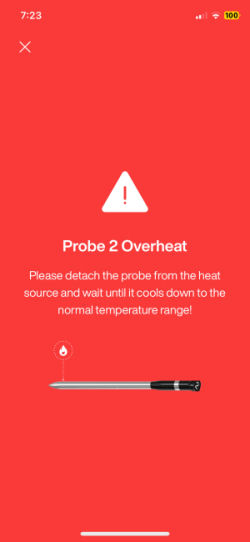
Hence we could only test room temperature and an ice water bath for the internal sensors. In the following tables, the error amount is shown in red if the value was outside Typhur's stated accuracy range. Otherwise, the error amount is shown in green.
| Typhur Sync Internal Sensor Accuracy Data, Room Temperature (71.5°F) | ||||||||||||||||||||||||||||||||||||||
|---|---|---|---|---|---|---|---|---|---|---|---|---|---|---|---|---|---|---|---|---|---|---|---|---|---|---|---|---|---|---|---|---|---|---|---|---|---|---|
| . | ||||||||||||||||||||||||||||||||||||||
Probe 1 |
Probe 2 |
|||||||||||||||||||||||||||||||||||||
| Typhur Sync Internal Sensor Accuracy Data, Ice Water Bath (32.9°F) | ||||||||||||||||||||||||||||||||||||||
|---|---|---|---|---|---|---|---|---|---|---|---|---|---|---|---|---|---|---|---|---|---|---|---|---|---|---|---|---|---|---|---|---|---|---|---|---|---|---|
| . | ||||||||||||||||||||||||||||||||||||||
Probe 1 |
Probe 2 |
|||||||||||||||||||||||||||||||||||||
As you can see, probe 1 had 10 our of 10 readings outside Typhur's stated accuracy. Probe 2 had 3 out of 10 readings outside the stated accuracy. So, not very impressive. You may wish to perform this sort of test for your own probes and then take any error into account when actually cooking.
Ambient Sensor: We also checked the accuracy of the ambient sensors in boiling water by holding the probes upside down and immersing only the handle. What we found was that probe 1 read about 4.0°F too high, and probe 2 read about 2.0°F too high. Well within the ±9.0°F stated by Typhur, but still not very impressive.
That said, the behavior of the ambient sensor when cooking can be affected by such things as things the bubble of cool air that exists near the surface of the cold meat. Inserting your probe too deeply into the meat lest the ambient sensor be too close to the cold meat. The roasting pan, using a glass container, the proximity of the ambient sensor to the walls of the cooker, the “cold” spots of the oven, the size of the roast, etc. etc. etc. And you should be aware that the purpose of the ambient sensor is not to tell you the temperature of your cooker. Let us repeat that. The purpose of the ambient sensor is not to tell you the temperature of your cooker. The actual purpose of the ambient sensor is to measure the temperature of the air near the meat for use in predicting cook finish times.
If you dig into the Apption Labs patent application for its MEATER probes and look at paragraph 46:
"As noted above, more accurate predictions on completion time and resting temperature rise can ordinarily be made by utilizing dual-sensor technology. Using an ambient or external thermal sensor in or near the third portion 102 can enhance estimation of heat input at the location of the food 108, which can vary when the food 108 is moved, turned, or when changes in cooking environment occur, such as opening the hood of a BBQ, adjusting heat on a gas grill, or charcoal fuel losing heat. The heat input at the location of the food 108 can be estimated more accurately using an ambient or external thermal sensor adjacent an exterior surface of the food 108 and measuring the ambient temperature over a period of time."In other words, you can better estimate the completion time of your cook, if you know the temperature of the air immediately adjacent to the meat you are cooking. So we would advise you to just ignore the ambient sensor's reading and let the App use it for its own purposes.
 |
NUGGET ALERT: The purpose of the ambient sensor, as we have explained, is to give the App information about the air temperature near the surface of your meat. Therefore the ambient sensor will report the most accurate temperature to the App if the probe is inserted into the meat up to the handle, thus placing the ambient sensor as close to the meat as possible. |
Setting Up Bluetooth and Wi-Fi
Up until now, we haven't used the App because you can use the probes and the base unit together to do basic
temperature monitoring. However, if you wish to monitor things on your smart device, you will need to pair
the base unit to your phone, and set up Wi-Fi so that the base unit can connect to the internet. This will
allow you to monitor your probes anywhere that you have access to the internet. The process is pretty simple:
So we'll now take you through all the screens on the App to accomplish this. First, download the Typhur App to your phone. There are versions for both iOS and Android. Then proceed as follows:
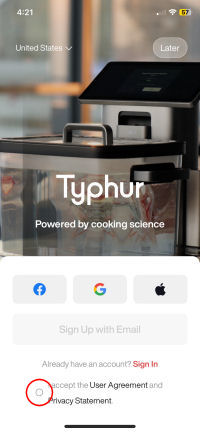 1. When you first start the app, tick the box saying you agree with their user agreement, etc. |
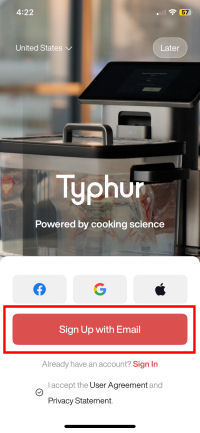 2. Now tap on the button that says "Sign Up With Email". |
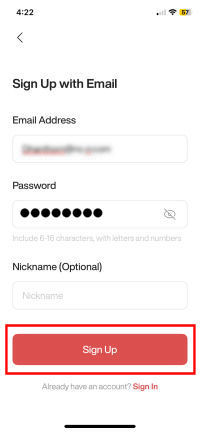 4. Enter your email address and a password, then press "Sign Up". |
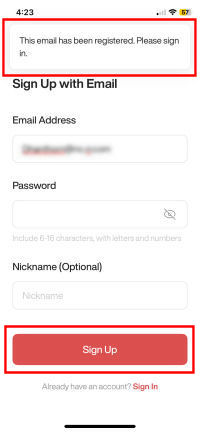 5. If successful, you will get a message at the top saying that your email has been registered. Now you need to sign in. Press the "Sign Up" button. |
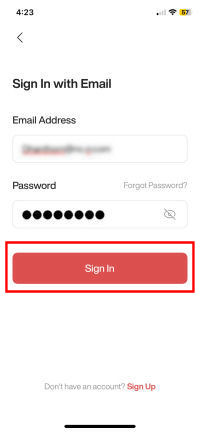 6. Enter your email address and password again and tap on "Sign In". |
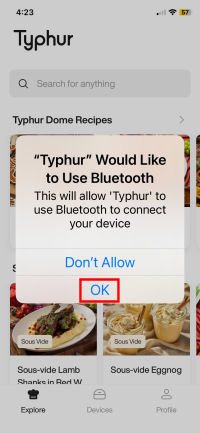 7. Next tap on "OK" to allow the App access to Bluetooth. |
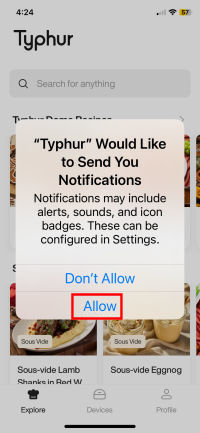 8. Then tap on "Allow" to allow the App to send you notifications. |
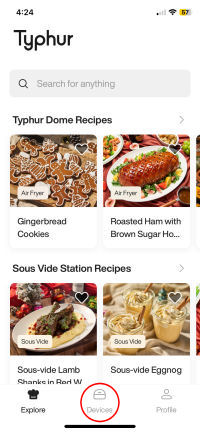 9. Now you are in the App. To begin the pairing process tap on "Devices". |
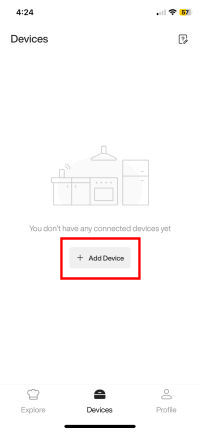 10. Tap on "Add Device". |
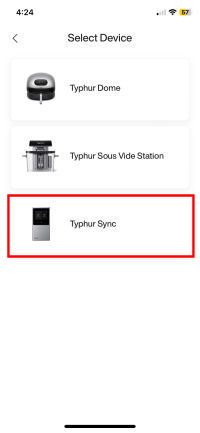 11. Tap on the image of the Typhur Sync. |
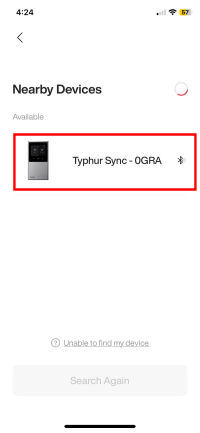 12. The App searches for your base unit. Tap on the image of it. |
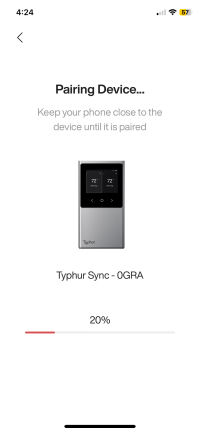 13. The App will now pair with your base unit. |
 14. You now have 30 seconds to press the ENTER button on your base unit to confirm the pairing. Tap "OK". |
 15. The App then notifies you that Pairing is complete. Tap "Done". |
 16. Next, the App wants to connect to Wi-Fi. It gives you a list of available networks. Tap on the one you wish to use. Tap on "Skip" if you don't wish to set up a Wi-Fi connection. |
 17. You are prompted to enter your network password. |
 20. Enter your network password and then tap on "Connect". |
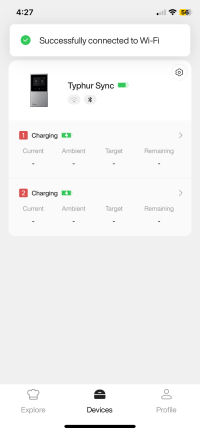 21. Finally, you are all set up. Once connected to the network, the App shows you the main screen for your base unit. |
 |
NUGGET ALERT:
Typhur advises that while you don't absolutely need to use |
You can support this website by shopping at The Naked Whiz Website Store and Amazon.com
|